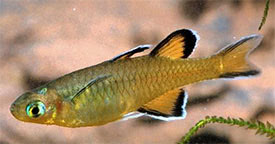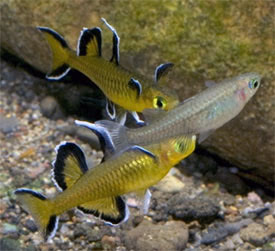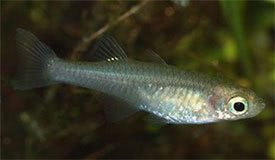
 Magyarul / Hungarian
Magyarul / Hungarian




- Scientific name: Pseudomugil mellis
- Synonyms: -
- Common name: Honey Blue-eye
- Group: Rainbowfish
- Habitat: Australia, Queensland, along the coast from Brisbane to Bundaberg area.
- Size: 3-4 cm
- Biotope: Inhabits ponds and small streams near the coastline. These habitats are typically slow-flowing, tannin-stained swamps and streams with sandy or muddy substrates and abundant aquatic vegetation.
- Social behavior: Active, very peaceful schooling fish. Can be kept with other small, peaceful species, but it is best kept in a species tank.
- Diet: Omnivorous; Unfussy, eats everything from small live foods to flakes.
- Breeding: Quite easy
- Tank: Minimum 30 litres
- Population: 6-8 fish for 45 litres
- Decoration: Needs a tank with dense vegetation and open areas for swimming. Also put some floating plants to the tank as these fish stay close to the surface. The dense aquatic vegetation make the fish more secure, and they can hide among the plants when frightened.
- Temperature: 24-28 °C
- pH: 6-7.5
- Hardness: 5-12 NK°
- Lifespan: 3-5 years
Description: Honey Blue-eyes – as their name indicate – are small rainbowfish with pale honey colored body. Males have brownish colored fins with distinct black submarginal bands and white margins. The body scales are lightly edged with black forming an attractive latticework pattern. The female and juveniles have a plain amber colored body with clear fins. They have two dorsal fins, very close together, the first much smaller than the second. The sexes are easily distinguished as males have brighter colors and longer and more elongated dorsal fins. Honey blue-eyes will school from about 25-70 individuals in nature. Until 1996, Pseudomugil mellis was listed as Vulnerable on the IUCN Red List of Threatened species, but now it has been listed as Endangered, as its natural habitat shrink due the urban development and the spread of the introduced mosquitofish (Gambusia holbrooki). Earlier, it was considered a variety of Pseudomugil signifer.
In their natural habitat females ready to release eggs have been found from September to January. Spawning in the wild occurs at temperatures in the range of 26-28 °C. The Honey Blue-eye reaches sexual maturity when 5 months old, and can be bred in pairs or groups. At this time females are 17-22 mm in size, and larger females producing more eggs than smaller ones. In captivity males exhibit territorial behaviour guarding the spawning site from intruding conspecifics. Condition the fish with plenty of live foods before spawning and use a breeding tank with small clumps of fine-leaved plants such as densely grown java moss, that can be used as a spawning medium. During spawning the male rising his fins and swimming in a zigzag pattern to block the female’s retreat. Unlike many other rainbowfishes that spawn in the early morning, Pseudomugil mellis is more likely to spawn in the afternoon. The female Honey Blue-eye will only release a small amount of eggs each day, usually 5-10 eggs every 24 hours. The eggs should be placed to a separate tank, since the adult fish might eat the fry. Spawning can last for about 7-9 days, and a total of 42-125 eggs can be released over that period. The eggs hatch in 12-14 days at a constant water temperature of 24 °C, and the fry will usually feed from the surface of the water. At slightly elevated water temperatures of 25-27 °C eggs hatch between 5 and 8 days. They should be fed with infusoria or similar small foods until they are large enough to eat newly hatched brine shrimp.
The secret in maintaining long-term captive populations of Pseudomugil mellis is to constantly breed them. There is a reduction in the frequency and intensity of spawning activity in fish over one year of age. If you fail to notice the change they become too old and then you just lost them. Try to obtain 6-12 young specimens and breed them early and regularly and you always have some around to enjoy.















































